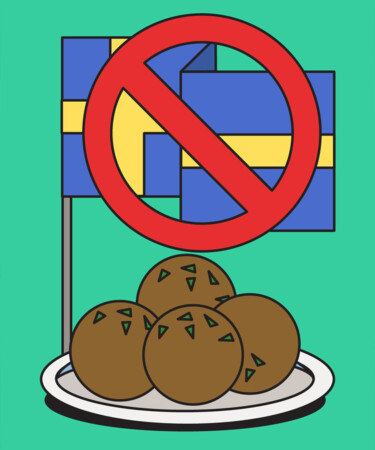This article is part of our Cocktail Chatter series, where we dive into the wild, weird, and wondrous corners of history to share over a cocktail and impress your friends.
After shopping for a new POÄNG to sit in, a practical SKRUVBY for your living room, or a state-of-the-art VINTERKALL for your kitchen, all good days at Ikea should end at the food court. And for most, the go-to order is Swedish meatballs slathered in gravy and plated with the usual accouterments, mashed potatoes and lingonberry sauce. The dish is a well-established cornerstone of Swedish cuisine, and one that the Swedes are vehemently proud of. That’s why Sweden’s official Twitter account stirred up a social media uproar when it proclaimed that its namesake meatballs are actually an import from another part of the globe.
Has the wool been pulled over our eyes this whole time? Well, the truth is, the story of Swedish meatballs is actually a bit complicated.
A Meaty Theory
To kick off the tale of the sacred Swedish meatball, we need to roll back the clock to the early 1700s. At the time, a young King Charles XII was fixated on defending the borders of the Swedish Empire, and at first, he was pretty damned good at it. He and his troops defeated the then-joined kingdoms of Saxony-Poland-Lithuania and Denmark-Norway before he set his sights on Russia. However, invading Russia turned out not to be the best idea. The Russians whalloped his troops in the 1709 battle of Poltava, forcing Charles and 1,000 of his men to flee to the Ottoman Empire, which encompassed what’s now modern-day Turkey.
For the next five years, Charles gallivanted around the Empire, awaiting his safe return to Sweden. It’s believed that during those years, Charles and his cohorts developed an affinity for traditional Turkish foods. According to the story Uppsala University researcher Annie Mattsson shared with Turkish news outlet Anadolu Agency in 2018, when Charles finally returned to Sweden in 1715, he brought with him Turkish coffee beans and the recipes for dolma and köfte. From there, it’s presumed that the two recipes morphed into what we now know as stuffed cabbage rolls and Swedish meatballs. The first documented recipes for both — called kåldolmar and kötbullar, respectively — appeared in cook Cajsa Warg’s 1755 book, “Guide to Housekeeping for Young Women.”
As straightforward as this all sounds, it turns out that this is just one version of the meatballs’ origin story.
The Counter Argument
According to some historians, Charles XII wasn’t necessarily the foodie that others claim him to be.
“There is no documented interest from him in food,” food historian Richard Tellström told media company Great Big Story in 2019. “No mentioning of meatballs there. They are not Turkish because we can’t follow the original meatballs in the world.”
While it’s entirely possible that Charles still played a hand in the development of the modern-day Swedish meatball, the köfte-to-meatball pipeline is shrouded in hearsay and assumption. The truth is, trying to figure out who first invented the meatball is like trying to pin down the origin of soup. The roots are anything but clear, and it’s more than likely that versions of meatballs were born near-simultaneously in different parts of the world.
Even Sweden’s official Twitter account backtracked on its initial statement in early May 2018, tweeting: “We had little doubt about its origins last week. We’ve since come to realise that culinary history is complex.” In a follow-up tweet that same day, the Nordic nation wrote, “Swedish food has been influenced by many foreign cultures. The same can be said about nearly all food cultures. Having said that, we should have looked deeper into the origins and history of Swedish meatballs before tweeting.”
Someone had to be the very first to craft the beloved Swedish delicacy, but who that was we’ll never know. On the bright side, if you really want to give the nation its flowers, it definitely gave us ABBA and affordable, minimalist furniture — so kudos to the Swedes on that front.
*Image retrieved from Brent Hofacker via stock.adobe.com
